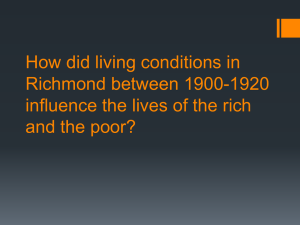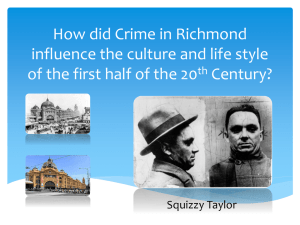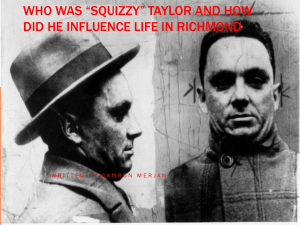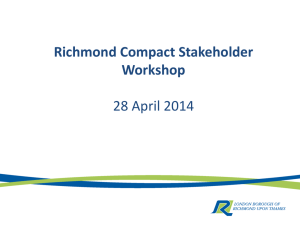A Closer Look: - Further The Work
advertisement
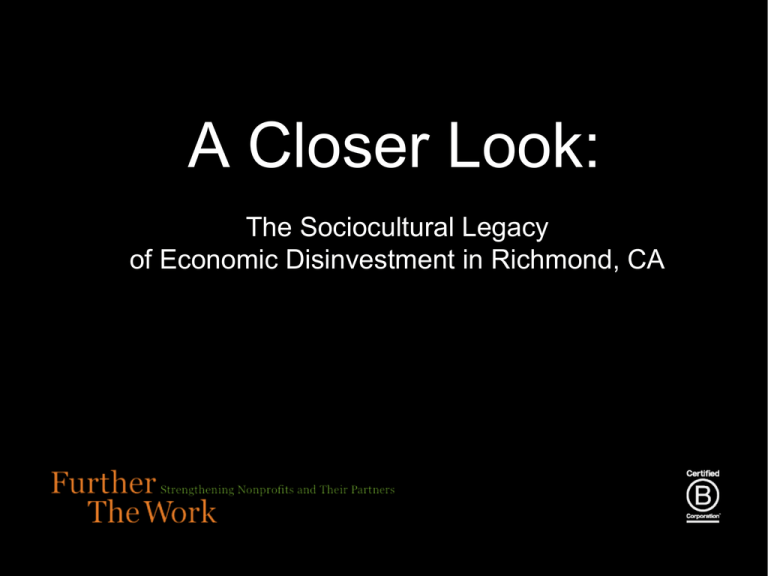
A Closer Look: The Sociocultural Legacy of Economic Disinvestment in Richmond, CA Healthy Richmond: Situating Our Work Richmond hugs the western edge of Contra Costa County, in San Francisco’s East Bay. Richmond’s access to multiple waterways, and its direct connection to the continental landmass (unlike SF), have been critical to its history. [Note the town of Milpitas. We’ll come back to it later.] Richmond: 30 square miles of land and 32 miles of shoreline North Richmond is an unincorporated area under County jurisdiction. Immediately adjacent to Central Richmond, the gradual emergence of South Richmond was fostered by industrial growth in the 1940s. Since the 1950s, a great deal of land has been annexed to Richmond, giving rise to suburbanstyle bedroom communities (and even a country club). In the ’70s, Hilltop Mall opens, five miles from downtown. The Iron Triangle, in Central Richmond, is the historic heart of Richmond, named for the three railway lines that mark its boundaries. An Extraordinary Confluence: Four Forces Shaping Richmond, 1900-1950 1. 2. 3. 4. Natural Assets: • Cheap and readily available unimproved land carried over from 19th-century landgrants • Calm bay inlets easily connecting to open ocean Infrastructure Development: • Coast-to-coast railway connection, with railway terminus within the city (1900) • Ferry system from Richmond to Alameda, San Francisco (1900) • Dredged port and customized landfill (1910-1920) Financial and Economic Demand and Capital: • Local, risk-tolerant businessmen with access to capital (1900-1940) • War-fueled escalation of demand, with focus on efficiency and productivity (19401945) Social Mobility: • In-migration from the American South following Reconstruction (1920s and later) • In-migration from the American Midwest following the Dust Bowl (1930s) Not a Bubble: A Boom (1900-1950) • • • • • • • • 1892: The Giant Powder Company opens on the northern shore, creating the small company town called Giant. Later, the 2,500 acres will be annexed to Richmond, becoming Point Pinole Shoreline. 1900: Augustin Macdonald persuades Santa Fe Railway to establish a terminus in Richmond with a ferry to San Francisco, completing the transcontinental railway, with ferry service to San Francisco. Later, Pullman Company will build sleeper cars and employ African American men as porters. 1901: Standard Oil Corporation (now Chevron) establishes operations in Richmond. In the 1950s and ’60s, 1000s of acres of Chevron’s “tank farms” will be sold to Richmond & developers for houses. 1907: Mechanics Bank is established to serve railway workers, who are called “mechanics.” Later, while still based in Richmond, it expands to serve the larger region. 1912: San Pablo Bay is dredged to allow deep water shipping. The dredged silt is in turn used to build a bay-side landmass, on which the Ford Assembly plant will be built. 1915: The Panama Canal opens. Richmond becomes a major Pacific mercantile port. 1931: Ford Assembly Plant opens, after Fred Parr assumes all costs of building the plant on spec to Ford. Grows to employ over 2,000 people. 1939: Henry Kaiser opens the Kaiser Shipyard, which soon becomes a leading military supplier. • • • 1940: Kaiser Medical is formed to provide medical care to employees. 1941-1945: Kaiser builds tens of thousands of units of housing for Kaiser employees. One of these was Atchison Village, built through a collaboration of local/federal agencies, for mostly white workers. 1941-1945: Daycare facilities for Kaiser families are opened in response to the female workforce. A Rising Tide: Heavy Industry Leads to a Whole New Infrastructure.... “[During the war,] Kaiser was early in requesting that the Maritime Commission help address the housing shortage in Richmond.... The Maritime Commission made several addenda to the [Kaiser contract] in order to build housing, schools, and other community facilities. The first, awarded 10 September 1942, was to build 6,000 units of housing [900 two-bedroom, 4,000 one-bedroom, and 1,100 single-room] and a school.... The next addendum, dated 17 December 1942, was for another 6,000 units of housing. A third awarded in 1943...called for 4,000 more units of housing, 4,000 dormitory rooms, schools and nurseries, a market, hospital, and a community center.” Historic American Engineering Record, prepared for The National Park Service, Rosie the Riveter/World War 11 Home Front National Historical Park, Frederick L. Quivak, 2004, p. 206 Kaiser Shipyard, circa 1942 During WWII, 767 Liberty Ships were built at the Kaiser shipyards. Scale and Productivity: Day 3 in Building a Liberty Ship, Kaiser Shipyard, 1942 Richmond’s shipyards led the nation in number and speed in the production of Liberty ships. It took an average of about 17 days to build a Liberty Ship in Richmond; its record was five days. Shift Change: Kaiser Shipyard, 1942 The shipyard ran 24 hours a day, 7 days a week, for five years. Skilled Trade Managers at the Shipyards Shipyard #4, August 1944 Buford Payne, 4-Yard Bond Coordinator; Fred Alexander, Pipe Welding Superintendent; Wm. Pierce, Masterpiperfitter; R. Tracy, Asst. Master Welder; Chas. Bradford, Burner Superintendent; Fred Hamby, Master Riveter; Ernie Rossi, Ass't O.F.D. Hull Supt; Vince Millicich, Master Shipfitter; Ed. O'Gaffney, Hydrostatic Tests; J. W. Beidler, Master Welder; Harry Feldhahn, Plant Maintenance Superintendent; Ray Hamilton, Fabrication Superintendent; Earl Stiles, Safety Superintendent; Ivan Duncan, Master Shipwright; A. Underkoffler, Hull Superintendent; Helmer Ingebrigtsen, Chief Trial Engineer; Art Mori, Master Loftsman; H. McDonald, Machinist Superintendent; Harry Tipps, Equipment Superintendent; 0. K. Outman, Sheetmetal Superintendent; M. T. Melvin, Ass't Outfitting Superintendent; J. A. Cbokae, Machine Shop Superintendent W. W. Cooper, Master Boilermaker.R Feenstra, Chief Clerk; Jack Stoddard, Bond Manager; K. L Sage, Outfitting Superintendent; R. Johnson, I. B. M. Dept Yard Two; G. Devereaux. 4-Yard Bond Accountant; J. C. Konrad, General Superintendent; C. P. Bedford, General Manager Richmond Shpyds; M. G. Vanderwende, Executive Ass't; J. A. Sullivan, Warehouse Superintendent; W. F. Tustin, Labor Superintendent; T. C. Goff, Ironworker Superintendent; R. L. Davis, Stage Rigger; C. A. Walker, Yard Superintendent. Hard to Imagine, But Archives Tell Us.... In early 1943, there were 85,100 people employed in the Richmond Kaiser shipyards. An emphasis on health and an awareness of environment’s effect on health, and health’s connection to economic development are present from the start. Kaiser quickly realized that a productive shipyard depended on healthy people: and Kaiser Medical was born. A family of six people lived in this converted vehicle. This woman asked for one thing: a place to cook. Nationwide Forces Highlighting Ethnicity and Power Challenge Deep Social Dynamics For Centuries, Land, War, and Heavy Industry Have Shaped the Region’s Cultural Mix • • • • Pre-Columbian millennia: Hunter-gatherer-fisher Ohlone Indians were the first residents of what is now called Richmond. 18th century: Spanish explorers and conquerors came to dominate the southwest; eventually, Mexico won independence from Spain, and soldiers were awarded large land-grants. Crespi and Castro were awarded over 40,000 acres. 1910s-1942: For decades, Japanese Americans ran successful family flower nurseries. However, in 1942 Japanese residents were forced to leave their homes and businesses, interned in WW2 relocation camps. They were allowed to return after the war, but their businesses and families were forever altered. 1920s-1980s: In order to gain access for the developing transcontinental railroad, and during a nation-wide railway workers strike, the Santa Fe Railroad company promised jobs in Richmond for members of the Lagunas and Acomas Native tribes in New Mexico. Native Americans were housed in boxcars in the Santa Fe Railroad Indian Village. • • • • • • Socioethnic Changes Accelerate in the 20th Century 1940s: Driven off Midwestern farms by the great American dust bowl of the 1930s, poor White, rural migrants make their way to the new jobs in Richmond. They live outdoors, in shacks, tents, and converted vehicles, and share “hot beds.” 1940s: Leaving the oppressions of the Jim Crow South, poor Black, rural migrants make their way to the new jobs in Richmond. They still face segregation; drinking fountains, schools and movie theatres remain segregated until the 1960s. Originally planned by developer Fred Parr as an integrated community, Parchester becomes a Black neighborhood when Whites refuse to live there. 1950s-present day: As skilled trades leave the region and other populations move in, White residents leave Richmond by the thousands; those who remain live in the new developments in the suburban-style areas made possible by annexation. 1970s-present day: Southeast Asian immigrants fleeing war-torn Vietnam, Laos, and Cambodia form a small community made up of several ethnic tribes, and the overall Asian population slowly but steadily grows. Late 1980s-present day: Central Americans and South Americans make their way to California; drawn primarily by relatively low-cost housing in the aftermath of industrial decline, increasing numbers settle in West Contra Costa County. What was once seen as a Black and White town becomes seen as a Black and Brown town. 1899: Railway erminus and erry Richmond’s Population 1900-2010 125000 100000 75000 50000 25000 0 1900 1910 1920 1930 1940 1950 1960 1970 1980 1990 2000 2010 1939: Kaiser 1953-1957: 1901: Standard 1931: Ford 1955: Ford 1976: Hilltop 1912-1917: Shipyard The City Oil Plant closes Mall opens Harbor dredged Plant opens opens annexes land 2000-2005: 1990 and Richmond endures onwards: Immigration from a staggering municipal fiscal Mexico and Central America crisis, running a 30% deficit in 2003increases. 2004. Maybe It Hadn’t Been a Bubble... But There Was a Bust, Nonetheless (1945-2000) • • • • • • 1946: Post-war conversion of industrial manufacturing centralizes in the midwest, with its ready nation-wide distribution capacities. Outmigration from Richmond begins, as skilled laborers with transferrable, portable skills move east to pursue the post-war boom. 1947: Kaiser shipyard closes down. Thousands of units of substandard housing remain in downtown Richmond. 1953-1957: Richmond annexes substantial amounts of outlying land, expanding city boundaries and creating a “suburban” ring. Bedroom communities develop, pulling many middle-class people away from downtown and attracting commuters from other areas. 1955: To accommodate increased market demand for cars, the Richmond Ford Assembly plant closes, and a larger plant opens in Milpitas. 1968: Racial unrest flares across the country; there are riots in downtown Richmond, which by now is almost entirely African American. 1976: Richmond’s Hilltop Mall opens, 5 miles north of downtown, serving the annexed “suburban” neighborhoods. It is a death blow for Macdonald Avenue, Richmond’s longtime Main Street. Out-Migration and Population Loss: A Fateful Combination in Richmond “[The combination of] out-migration and population loss is detrimental to a region...because the migration process selectively removes [many of the] ‘best and brightest,’ damaging the region’s endowment of human capital and therefore its competitiveness. Out-migration, Population Decline, and Regional Economic Distress”, 1/99, by Edward J. Feser and Stuart H. Sweeney, Department of City and Regional Planning, University of North Carolina Chapel Hill Funded by the Economic Development Administration, U.S. Department of Commerce, p. 53 Profound Cultural Shift During Out-Migration and In-Migration Local Governments Suffer the Effects Of Out-Migration and Population Loss “[S]evere boom-bust cycles accompanied by particularly rapid population adjustments can damage the fiscal position of local governments as maintenance of infrastructure and services expanded during a boom must be financed by dwindling populations with fewer financial resources following a bust.” •Op. cit., Feser and Sweeney, i. By 2003, the City of Richmond is nearly bankrupt. Scarcity Becomes the Order of the Day • In the decades following post-industrialism and in the face of substantial shifts in demographics, the City struggles to find its footing. • Taking advantage of open land and land conversion, the City increasingly depends on residential housing development and property taxes to support the economy. • Suburban-style development removes business from downtown Richmond, abandoning an increasingly disenfranchised population. • The need for public services (federal, state, and local) increases, but the tax base can’t keep up with demand. Following 1978‘s Proposition 13 limiting property taxes, critical services (including public schools) suffer decades of diminishing funding. • Nonprofit organizations find themselves shouldering a greater burden; but with little margin for reinvestment, they spiral into a cycle of “critical needs” without longer strategies for sustainability. Enter: Systems Change In his essay "Life and Leadership," Fritjof Capra explains that natural and social systems usually remain in a stable state. Every now and then, some event or new information affects a system so strongly that it must change some of its structures, practices, or beliefs. Facilitating community creativity in the face of changing conditions requires a new type of leader: people who: • • • • • • • • establish conditions rather than giving directions use authority to empower others promote networks of communications create a climate of trust and mutual support encourage questions and reward innovation loosen control and share responsibility more widely and anticipate surprises, because emergent change has its own dynamics, and cannot be completely managed. 1. What It Takes: Dedicated Resources and Shared Goals Intellectual leadership, vision, and advocacy providing consistent, sustained attention and organizing • • • To spur wholesale community economic and social development To advise, advocate, agitate, educate, and hold accountable To identify and pursue external opportunities that would serve the City 2. Municipal leadership • • Willing to invest substantial local dollars and to identify and leverage external dollars Able and determined to promote broadscale partnership and longterm investment 3. Business leadership • That goes beyond “business mixers” and simplistic questions like, Business taxes: good or bad? What It Takes: Shared Information and Intention 4. Philanthropic leadership • • To cultivate comprehensive, localized knowledge to inform their investments Willing to commit to longterm goals enacted by partnerships, to raise the tide 5. Capacity-building resources (and expectations) for nonprofits to counteract the “nonprofit starvation cycle” 6. Public systems (schools, health) committed to multi-sector pilot programs with tracked and targeted outcomes, not anecdotes 7. Community residents who are informed, engaged, and able to organize for collective and effective action Building Healthy Communities To Build a Better Future People ask me to predict the future, when all I want to do is prevent it. Better yet, build it. Predicting the future is much too easy, anyway. You look at the people around you, the street you stand on, the visible air you breathe, and predict more of the same. To hell with more. I want better. ~ Ray Bradbury, “Beyond 1984: The People Machines,” in Cities: The Forces That Shape Them, Lisa Taylor, ed., 1982 We don’t have to keep going around in circles. “Rather than scramble for a comfy spot in the current system, spend some time with other interested people imagining and designing a system you would prefer.”


